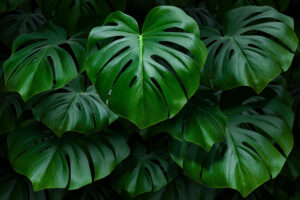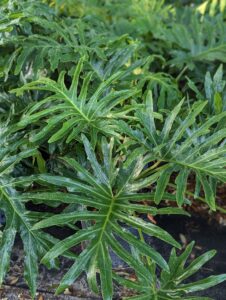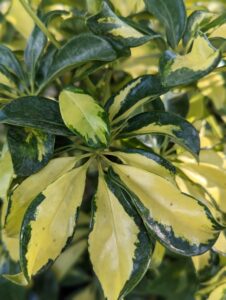By: Anna Stubbendick, FCHP
As I write this blog post, I’m currently enjoying the cooler, much less humid air, of central Wisconsin. It’s quite a contrast from our humid Florida summers!
Whenever I’m anywhere, the plant nerd in me always has to find local nurseries and botanical gardens to wander. I love comparing the local flora and different landscaping styles to the plants that we typically see back home in the Tampa Bay area. For some reason though, I’m always surprised when I see familiar Florida plants at nurseries “up Nort.” But then I have to take a step back and notice what section of the garden center I’m in… the houseplant section. It’s so easy to forget that so many of our favorite tropical plants that we use everyday in our landscapes in Florida can also make great houseplants.
So I thought I’d take the opportunity today to spill the beans on some amazing shade-tolerant tropical plants that can usually be found at Canterbury Farms Nursery & Garden Center, and that can double as stunning houseplants. So, let’s dive in and discover how you can transform your living space into a tropical oasis!

Word of the Day: Fenestrate
An adjective meaning having small perforations or transparent areas. Photo by Adobe Stock
Monstera: The King of Jungle Elegance
First up, we have the magnificent Monstera Deliciosa, commonly known as the Swiss Cheese Plant. This eye-catching beauty has become an Instagram favorite, and for a good reason! With its large, fenestrated leaves, the Monstera can add a touch of jungle elegance to any room. It thrives in indirect light, making it a perfect candidate for those corners that need a little green magic. Many different varieties of Monstera have found their way into the houseplant market lately, including special collector varieties, which can carry a hefty price tag. For beginners, be on the lookout for the basic green variety, until you’re sure that you’re going to be a successful Monstera plant parent. Keep its soil moderately moist, and it will reward you with new leaves unfurling before your eyes!

The Split-Leaf Philodendron (Philodendron selloum) is a popular landscape plant since it can grow large and it does not take many plants to fill in an area. Be sure you have enough room in your house to let this baby grow! Photo by Anna Stubbendick, Canterbury Farms
Philodendron: The Low-Maintenance Sweetheart
If you’re looking for a houseplant that’s easy to care for and incredibly forgiving, then the Philodendron is your go-to choice. These charming green darlings come in various shapes and sizes, from heart-shaped leaves to trailing vines. They can handle low light conditions like a pro, making them ideal for those cozy spots where other plants might struggle. Be sure to let the soil dry out a bit between watering sessions, as Philodendrons don’t appreciate being overwatered. Some varieties of Philodendron can grow very large and potentially take over a space in a house. If you’re unsure about the mature size of the Philodendron that you’re considering, please ask one of the knowledgeable plant pros on staff at Canterbury Farms. They can help you find a plant that’s perfect for the space you have in mind.
Ficus: The Statement Piece
Now, let’s talk about the Ficus family, which includes the popular Fiddle Leaf Fig (Ficus lyrata) and the Rubber Plant (Ficus elastica). These indoor trees are all about making a statement! With their bold and glossy foliage, they demand attention and admiration. Ficus plants prefer bright, indirect light, but they can also adapt to moderate light conditions. Make sure to check the soil regularly and water when the top inch feels dry. Pro tip: Ficus plants don’t like being moved around too much, so find them a happy spot and let them be.
Dracaenas and Cordylines: Air-Purifying Beauties
If you’re concerned about air quality in your home, look no further than Dracaenas and Cordylines. These tropical wonders not only add a burst of color with their vibrant foliage but also work tirelessly to purify the air you breathe. They can tolerate lower light levels, but they prefer medium to bright indirect light for optimal growth. Allow the soil to dry partially between watering to prevent root rot, and mist the leaves occasionally to boost humidity.

The colorful variegated leaves of Arboricola can brighten up a room and provide a nice contrast to the traditional greens of most houseplants. Photo by Anna Stubbendick, Canterbury Farms
Schefflera: The Tropical Umbrella Tree
Lastly, let’s talk about the Schefflera, also known as the Umbrella Tree. At Canterbury Farms, our best-selling landscape plant by far is the variegated Schefflera Arboricola ‘Trinette,’ which is a dwarf variety of Umbrella Tree. We sell so many of the plants, we usually just call them Arboricola, or even just “Arbs.” Its bright, variegated leaves, which are arranged in circles of seven leaflets, create a beautiful canopy of green that can instantly transform your space into a tropical paradise. Scheffleras thrive in bright, indirect light but can adapt to lower light conditions too. Water them moderately and ensure good drainage to keep them happy and healthy.
Dealing with Pests and Other Tips
Now, let’s address the dreaded pests! Tropical houseplants, like any other indoor plants, can sometimes attract unwanted visitors. Keep an eye out for common houseplant pests like spider mites, mealybugs, and aphids. If you spot any, don’t panic! There are plenty of natural and eco-friendly remedies available to deal with these pesky critters.
Additionally, remember to dust the leaves of your tropical houseplants regularly. Dust buildup can hamper their ability to photosynthesize, leading to reduced growth.
Lastly, consider rotating your plants every few weeks to ensure even growth on all sides. This will also prevent them from leaning towards the light source and becoming lopsided.
And speaking of light, you should know that light intensity drops off drastically by moving even just a foot away from a window. One of the most common ailments that houseplant parents struggle with is their plants not receiving enough light. If you notice your plant not looking so great even though it is receiving proper watering, try moving it closer to a window so it receives more direct light. (Want to know more about lighting and caring for houseplants in general? Follow Darryl Cheng of @HouseplantJournal on Instagram for great tips and advice.)
So, there you have it—your guide to creating a lush tropical haven inside your home using shade-tolerant tropical houseplants! At Canterbury Farms Nursery & Garden Center, we have an amazing selection of these beauties, and our team is always here to help you choose the perfect plants for your space. Embrace the tropical vibes, and let the greenery take you on a journey to paradise right at home! Happy planting! 🌿🌴
